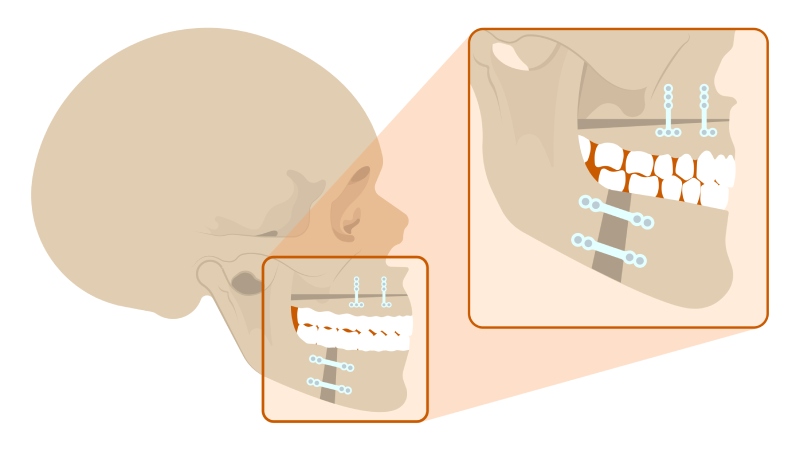13 January, 2022
What is orthognathic surgery and when is it necessary?

There are certain traces that decisively influence the image of people. So, the symmetry and the proportion are characteristics that are repeated in the traces that we consider attractive. Orthognathic surgery has a double objective: on one hand it corrects anatomical discrepancies when it comes to symmetry and facial proportions and, on the other hand, it corrects the dental malocclusion that has its origins in skeletal alterations.
WHEN IS IT NECESSARY TO OPERATE ON THE JAW?
Orthognathic surgery is an intervention that is recommended for functional and also aesthetic reasons. Faced with dental malocclusion and being a cause of a badly positioned maxillary bone and or jawbone, it will be possible to offer the patient surgical treatment. After the visit with a maxillofacial surgeon and an orthodontist, a treatment plan is carried out that is performed in coordination with both specialists and involves a orthodontic treatment phase and a surgical treatment phase.
Orthognathic surgery has another great indication that has been gaining more importance in the last 15 years: treatment of OSAS (Obstructive Sleep Apnea Syndrome) in those cases when the previous projection of the jaw is insufficient and lowers the space in the airway during sleep.
ORTHOGNATHIC SURGERY: PHASES OF TREATMENT
- Diagnosis: maxillofacial surgeon, via a physical exploration of the patient and the study of the requested diagnostic tests, should diagnose a sceptical problem to be treated surgically.
- Pre-surgical orthognathic treatment: after planning the case along with the specialist orthodontology, the orthodontic treatment will begin with the aim of preparing the case for orthodontic treatment. This treatment can last from a few months to two years, according to the degree of malocclusion. Preoperative orthodontics has different objectives to conventional orthodontics (when patients don’t undergo surgery), meaning that it should be very clear from the start whether the patient is a candidate or not for orthognathic surgery.
- Surgical treatment: the planning for orthognathic surgery is carried out over digital three dimensional models of the patient’s face. The patient can be “operated on” virtually to define the results that we want to achieve. This way, all the movements of the facial skeleton that are carried out in the surgery have been planned previously thanks to those digital models, on a computer screen.
- Post-surgical orthodontic treatment: is a shorter orthodontic phase than the first one (not usually more than 5-6 months) when the orthodontist has just “adjusted” the dental occlusion so that it’s perfect. The surgeon will carry out a follow-up on the evaluation during the next few months in collaboration with the orthodontist, which allows for optimal results.
What are the most common situations in which carrying out orthodontic surgery is recommended?
- Maxillary bone is very back
- Jawbone is very back
- Jawbone is very forward
- Narrow or pointy palate
- Very evident facial asymmetry
- A combination of the above
TYPES OF ORTHOGNATHIC SURGERY
With respect to the deformations to treat, there are basically two types of intervention:
- Class II skeletal, hypoplasia or retrognathism. It is the operation destined to correct a very back or slightly facing forward jaw.
- Class III skeletal or jaw prognathism. It is the appropriate technique for patients whose jaw is forward in relation to the maxillary bone.
These two citations can be associated with:
- Facial asymmetry: the patient has a decompensation between the two sides of their face.
- Gingival smile: when a person shows an excess of gum which is visible when talking or smiling and is not possible to correct exclusively via gingival surgery.
- Alterations in the shape of the chin
- Alterations in nasal anatomy
We have to mention that the different dental skeletal deformities described can be present alone or together. This makes the orthognathic surgery planning and the correct coordination with the orthodontist key aspects to achieve excellent results.
Esthetic surgery techniques, such as mentoplastia or rinoplastia, are commonplace in the treatment of this type of patient given that, as we have explained, the esthetic result and the dental occlusion are the two main objectives of this type of treatment.
“Esthetic surgery techniques, such as mentoplastia or rinoplastia, are commonplace in the treatment of this type of patient given that, as we have explained, the esthetic result and the dental occlusion are the two main objectives of this type of treatment.”
Dr. Samir Aboul-Hosn, oral and maxillofacial surgeon
ORTHOGNATHIC SURGERY AT BARNACLÍNIC+
Dr. Samir Aboul-Hosn is a maxillofacial surgeon with more than two decades of experience with orthognathic surgery. He has specialised in the field of orthognathic surgery in different national and international centres of prestige and has carried out his Doctoral Thesis work on digital surgical planning and 3D printing of material for orthognathic surgery. He has published scientific articles in this field, among them the third article most cited on orthognathic surgery on a global level. He has collaborated with different orthodontists to treat his patients. His idea about practical individualised medicine centred on the patient makes surgical planning a key point where, apart from technical aspects, active listening to the patient’s expectations take on special importance in all his visits. One of the most important aspects in the doctor-patient relationship, as he always tells his university students, is communication. This means listening, understanding, processing and explaining to the patient in the simplest possible way everything that their treatments entails.
Planificación tridimensional y utilización de férulas Computer Aided Design/Computed Aided Manufacturing en cirugía ortognática
Samir Aboul-Hosn Centenero
WOULD YOU LIKE TO CONTACT DR. SAMIR ABOUL-HOSN’S CENTRE?
REQUEST FACE-TO-FACE APPOINTMENT | REQUEST ONLINE APPOINTMENT







